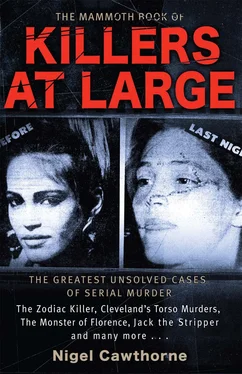The police tracked him down to Clio, Genesee County, five miles north of Flint, where he worked as a sprinkling-service employee. Then in February 2002, they began trailing him. On 7 February, Romulus Police Officer Mike St Andre picked up a cup Gorton left behind. DNA taken from the cup matched semen found in both the Ludwig and Eby cases. Two days later, Gorton was arrested. The following day he was charged with the murder of Margarette Eby in Genesee County.
During a search, police also found a 1982 gold Monte Carlo similar to one seen leaving the Hilton Airport Inn near Detroit Metropolitan Wayne County Airport on 18 February 1991. Inside the car, police found luggage similar to that used by Northwest Airlines employees. And on 11 February he was charged with the murder of Nancy Ludwig. He was arraigned in Romulus District Court on five felony counts of murder and criminal sexual conduct. Convicted in the Ludwig case, he pleaded no contest to the rape and murder of Margarette Eby.
Wayne County Assistant Prosecutor Michael Cox promised that detectives would be doing a thorough follow-up.
“There are a lot of things here that are very disturbing that we’ve uncovered,” Cox says.
Homicide investigators in Orange County, Florida, contacted Michigan authorities about the disappearance of a 14-year-old Vickey Willis in April 1983, when Gorton was living nearby in Orlando.
The investigation goes much wider than that. A total of 800 pairs of women’s panties labelled with dates and places were found in Gorton’s house. But that takes investigators no closer to the killer of the seven African-American women in Flint.
On 17 February 1981, the body of a young African-American woman was found in a vacant lot on the outskirts of Fort Lauderdale’s ghetto area. She could not be identified and the medical examiner could not determine the cause of death, describing it as a “homicide committed by unspecified means”.
On 1 June 1981, the skeletal remains of a black girl were found on the same patch of rough ground. She was roughly 13 years old, but she was carrying no form of ID. Again she could not be identified and a post mortem revealed no cause of death.
A third victim was identified. She was 30-year-old Eloise Coleman, a resident of the neighbourhood. Her corpse was found in the same lot on 10 June 1981, roughly 100 yards from where the first body was found. She had last been seen alive three days before when she left home on the evening of 7 June. This time the medical examiner could also determine the cause of death. It was described as blunt trauma to the victim’s head, caused by a powerful blow.
Despite the fact that all the bodies had been dumped on the same patch of waste ground, the police were reluctant to call the murders the work of a serial killer and the killer, or killers, remain at large.
The Fort Lauderdale Lacerater
Florida police found themselves investigating another series of unsolved murders in the Fort Lauderdale area, after the mutilated body of Delia Lorna Mendez was found in a dumpster on Federal Highway in nearby Hollywood on 21 May 1999. They sought to connect her death with the murder of four Fort Lauderdale prostitutes who worked the highway at one time or another.
At least three of the women had strawberry-blonde hair and a slender figure. Three were last seen strolling along US 1 in Fort Lauderdale and, when their bodies were found, they had been strangled. The fourth was mutilated and dumped near a Palm Beach highway.
Boston police flew to Florida, looking for connections between Mendez’s death and the murder of 20-year-old Swedish nanny Karina Holmer living in Dover, Massachusetts. She was last seen outside Zanzibar, a nightspot near Boston Common, between 3.30 and 4 a.m. on 22 June 1996. Her body was found in dumpster the next day by a man rummaging through the trash. She had been strangled and her torso was cut in half with surgical precision. The two halves of the body had been washed and placed in a garbage bag under a pile of rubble in the dumpster.
The Grand Rapids Grim Reaper
The murder of 11 women in the area around Grand Rapids, Michigan, remains unsolved. The police said that they were not sure that they were the work of a serial killer, though they assigned a task force of 15 to investigate.
The first victim was 25-year-old Lesa Otberg of Grand Rapids, whose body was found some 35 miles away in Muskegon in March 1994. Eight months later, another body was discovered to the south in neighbouring Ottawa County. The victim has not been identified. The remaining victims have been found in Grand Rapids itself, except for 29-year-old Victoria Moore. Her badly decomposed body was discovered by a squirrel hunter 20 miles north of the city.
Nine of the victims were prostitutes and at least five of them had contacts with the Rose Haven Ministry, a sanctuary for sex workers. By and large they were young white women with dark hair. Other than that, there are few clues and their killer remains at large.
The I–10 Long-Distance Lorry Driver of Death
Police in San Diego have been looking for a serial killer responsible for a string of murders along Interstate 10, the 2,500-mile highway running across eight states in the lower United States from California to Florida.
The investigation was instigated by a woman who accused a truck driver of a 1981 murder in San Diego’s Balboa Park, along with a string of slayings across the southern States. The unidentified female informant described how the 1981 killing was committed and took detectives to the spot, providing details that only someone who had witnessed the murder or who had been told about it by the killer could have known.
The woman said the truck driver had killed up to 20 people, largely prostitutes and hitch-hikers. Many were killed in Texas and their bodies deposited hundreds of miles away.
Law enforcement agencies all along I–10 had unsolved cases that might correspond to the trucker’s movements. They were afraid that the I–10 had struck again when the Baton Rouge serial killer began dumped his victims along the same Interstate some 1,800 miles to the east.
The I–35 had been the hunting ground of a serial killer—or killers—before. Between 1976 and 1981, there were at least 22 murders along the 420-mile stretch of the I–35 in Texas. The victims were largely hitchhikers and motorists in trouble.
The killer’s first “official” victim was 21-year-old Lesa Haley, who was hitch-hiking from Texas to Oklahoma City. She was last seen climbing into a van outside Waco. Her body was found dumped on the hard shoulder of the eastern branch of the I–35 two miles north of Waxahachie, Texas, on 23 August 1976. She had been stabbed in the neck with an awl.
On the night of 5 November 1978, Rita Salazar, aged 18, and Frank Key, 19, were out on a date in the state capital Austin, Texas, when they ran out of gas. The next morning, Frank Key’s body was found north of Georgetown. He had been shot nine times with a. 22-caliber pistol, including four shots in the back of the head after he was dead. Rita Salazar’s body was discovered 70 miles further on, dumped on a frontage road near Waco. She had been shot six times with the same gun.
On 3 September 1979—Labor Day—27-year-old Sharon Schilling was found 125 miles to the south of Austin on a street in San Marcos, Texas, just a few blocks from I–35. She had been shot once in the abdomen with a .410-gauge shotgun. She died ten days later without regaining consciousness.
Sandra Dubbs was driving from St Louis to San Antonio when her car broke down on the I–35 on 8 October 1979. She was abducted from the disabled vehicle. Her body was discovered near Austin in Travis County, Texas. She had been stabbed 35 times.
Читать дальше











